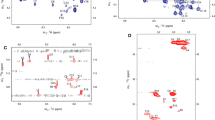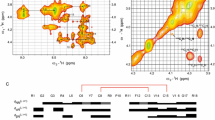Abstract
PG-1 adopts a dimeric structure in dodecylphosphocholine (DPC) micelles, and a channel is formed by the association of several dimers but the molecular mechanisms of the membrane damage by non-α-helical peptides are still unknown. The formation of the PG-1 dimer is important for pore formation in the lipid bilayer, since the dimer can be regarded as the primary unit for assembly into the ordered aggregates. It was supposed that only 12 residues (RGGRL-CYCRR-RFCVC-V) are needed to endow protegrin molecules with strong antibacterial activity and that at least four additional residues are needed to add potent antifungal properties. Thus, the 16-residue protegrin (PG-2) represents the minimal structure needed for broad-spectrum antimicrobial activity encompassing bacteria and fungi. As the peptide conformation and peptide-to-membrane binding properties are very sensitive to single amino acid substitutions, the solution structure of PG-2 in solution and in a membrane mimicking environment are crucial. In order to find evidence if the oligomerization state of PG-1 in a lipid environment will be the same or not for another protegrins, we investigate in the present work the PG-2 NMR solution structure in the presence of perdeuterated DPC micelles. The NMR study reported in the present work indicates that PG-2 form a well-defined structure (PDB: 2MUH) composed of a two-stranded antiparallel β-sheet when it binds to DPC micelles.






Similar content being viewed by others
References
Aumelas A, Mangoni M, Roumestand C, Chiche L, Despaux E, Grassy G, Calas B, Chavanieu A (1996) Synthesis and solution structure of the antimicrobial peptide protegrin-1. Eur J Biochem 237:575–583. doi:10.1111/j.1432-1033.1996.0575p.x
Bax A, Davis DG (1985) Mlev-17-based two-dimensional homonuclear magnetization transfer spectroscopy. J Magn Reson 65:355–360. doi:10.1016/0022-2364(85)90018-6
Bechinger B (2000) Understanding peptide interactions with the lipid bilayer: a guide to membrane protein engineering. Curr Opin Chem Biol 4:639–644. doi:10.1016/S1367-5931(00)00143-5
Blochin DS, Aganova OV, Yulmetov AR, Filippov A, Gizatulin BL, Afonin S, Klochkov VV (2013) Spatial structure of heptapeptide Glu-Ile-Leu-Asn-His-Met-Lys, a fragment of the HIV enhancer prostatic acid phosphatase, in aqueous and SDS micelle solutions. J Mol Struct 1033:59–66. doi:10.1016/j.molstruc.2012.08.018
Blokhin DS, Filippov AV, Antzutkin ON, Karataeva FK, Klochkov VV (2014) Spatial structure of oligopeptide PAP(248–261), the N-terminal fragment of the HIV enhancer prostatic acid phosphatase peptide PAP(248–286), in aqueous and SDS micelle solutions. J Mol Struct 1070:38–42. doi:10.1016/j.molstruc.2014.04.019
Brogden KA (2005) Antimicrobial peptides: pore formers or metabolic inhibitors in bacteria? Nat Rev Microbiol 3:238–250. doi:10.1038/Nrmicro1098
Chen VB, Arendall WB 3rd, Headd JJ, Keedy DA, Immormino RM, Kapral GJ, Murray LW, Richardson JS, Richardson DC (2010) Molprobity: all-atom structure validation for macromolecular crystallography. Acta Crystallogr D 66:12–21. doi:10.1107/S0907444909042073
Cho Y, Turner JS, Dinh NN, Lehrer RI (1998) Activity of protegrins against yeast-phase Candida albicans. Infect Immun 66:2486–2493
Davis IW, Leaver-Fay A, Chen VB, Block JN, Kapral GJ, Wang X, Murray LW, Arendall WB III, Snoeyink J, Richardson JS, Richardson DC (2007) Molprobity: all-atom contacts and structure validation for proteins and nucleic acids. Nucleic Acids Res 35:W375–W383. doi:10.1093/Nar/Gkm216
Delaglio F, Grzesiek S, Vuister GW, Zhu G, Pfeifer J, Bax A (1995) NMRpipe—a multidimensional spectral processing system based on unix pipes. J Biomol NMR 6:277–293. doi:10.1007/Bf00197809
Fahrner RL, Dieckmann T, Harwig SSL, Lehrer RI, Eisenberg D, Feigon J (1996) Solution structure of protegrin-1, a broad-spectrum antimicrobial peptide from porcine leukocytes. Chem Biol 3:543–550. doi:10.1016/S1074-5521(96)90145-3
Friedrich CL, Moyles D, Beveridge TJ, Hancock REW (2000) Antibacterial action of structurally diverse cationic peptides on gram-positive bacteria. Antimicrob Agents Chemother 44:2086–2092. doi:10.1128/Aac.44.8.2086-2092.2000
Gidalevitz D, Ishitsuka YJ, Muresan AS, Konovalov O, Waring AJ, Lehrer RI, Lee KYC (2003) Interaction of antimicrobial peptide protegrin with biomembranes. Proc Natl Acad Sci U S A 100:6302–6307. doi:10.1073/pnas.0934731100
Gottler LM, Bea RD, Shelburne CE, Ramamoorthy A, Marsh ENG (2008) Using fluorous amino acids to probe the effects of changing hydrophobicity on the physical and biological properties of the beta-hairpin antimicrobial peptide protegrin-1. Biochemistry 47:9243–9250. doi:10.1021/Bi801045n
Heller WT, Waring AJ, Lehrer RI, Huang HW (1998) Multiple states of beta-sheet peptide protegrin in lipid bilayers. Biochemistry 37:17331–17338. doi:10.1021/Bi981314q
Hill CP, Yee J, Selsted ME, Eisenberg D (1991) Crystal-structure of defensin Hnp-3, an amphiphilic dimer—mechanisms of membrane permeabilization. Science 251:1481–1485. doi:10.1126/science.2006422
Hwang TL, Shaka AJ (1995) Water suppression that works—excitation sculpting using arbitrary wave-forms and pulsed-field gradients. J Magn Reson Ser A 112:275–279. doi:10.1006/jmra.1995.1047
Jang H, Ma B, Woolf TB, Nussinov R (2006) Interaction of protegrin-1 with lipid bilayers: membrane thinning effect. Biophys J 91:2848–2859. doi:10.1529/biophysj.106.084046
Jang H, Ma BY, Nussinov R (2007) Conformational study of the protegrin-I (PG-I) dimer interaction with lipid bilayers and its effect. BMC Struct Biol. doi:10.1186/1472-6807-7-21
Jang H, Ma B, Lal R, Nussinov R (2008) Models of toxic beta-sheet channels of protegrin-1 suggest a common subunit organization motif shared with toxic alzheimer beta-amyloid ion channels. Biophys J 95:4631–4642. doi:10.1529/biophysj.108.134551
Jang H, Arce FT, Mustata M, Ramachandran S, Capone R, Nussinov R, Lal R (2011) Antimicrobial protegrin-1 forms amyloid-like fibrils with rapid kinetics suggesting a functional link. Biophys J 100:1775–1783. doi:10.1016/j.bpj.2011.01.072
Khandelia H, Kaznessis YN (2007) Structure of the antimicrobial beta-hairpin peptide protegrin-1 in a DLPC lipid bilayer investigated by molecular dynamics simulation. BBA-Biomembr 1768:509–520. doi:10.1016/j.bbamem.2006.11.015
Kokryakov VN, Harwig SSL, Panyutich EA, Shevchenko AA, Aleshina GM, Shamova OV, Korneva HA, Lehrer RI (1993) Protegrins—leukocyte antimicrobial peptides that combine features of corticostatic defensins and tachyplesins. FEBS Lett 327:231–236. doi:10.1016/0014-5793(93)80175-T
Koradi R, Billeter M, Wuthrich K (1996) MOLMOL: a program for display and analysis of macromolecular structures. J Mol Gr 14:51–55. doi:10.1016/0263-7855(96)00009-4
Lam KLH, Ishitsuka Y, Cheng YS, Chien K, Waring AJ, Lehrer RI, Lee KYC (2006) Mechanism of supported membrane disruption by antimicrobial peptide protegrin-1. J Phys Chem B 110:21282–21286. doi:10.1021/Jp0630065
Lippens G, Dhalluin C, Wieruszeski JM (1995) Use of a water flip-back pulse in the homonuclear noesy experiment. J Biomol NMR 5:327–331
Liu ML, Mao XA, Ye CH, Huang H, Nicholson JK, Lindon JC (1998) Improved WATERGATE pulse sequences for solvent suppression in NMR spectroscopy. J Magn Reson 132:125–129. doi:10.1006/jmre.1998.1405
Mani R, Tang M, Wu X, Buffy JJ, Waring AJ, Sherman MA, Hong M (2006) Membrane-bound dimer structure of a beta-hairpin antimicrobial peptide from rotational-echo double-resonance solid-state NMR. Biochemistry 45:8341–8349. doi:10.1021/Bi060305b
Matsuzaki K (1999) Why and how are peptide–lipid interactions utilized for self-defense? magainins and tachyplesins as archetypes. BBA-Biomembr 1462:1–10. doi:10.1016/S0005-2736(99)00197-2
McDonnell PA, Opella SJ (1993) Effect of detergent concentration on multidimensional solution NMR-spectra of membrane-proteins in micelles. J Magn Reson Ser B 102:120–125. doi:10.1006/jmrb.1993.1073
Pettersen EF, Goddard TD, Huang CC, Couch GS, Greenblatt DM, Meng EC, Ferrin TE (2004) UCSF chimera—a visualization system for exploratory research and analysis. J Comput Chem 25:1605–1612. doi:10.1002/Jcc.20084
Piotto M, Saudek V, Sklenar V (1992) Gradient-tailored excitation for single-quantum NMR-spectroscopy of aqueous-solutions. J Biomol NMR 2:661–665. doi:10.1007/Bf02192855
Porcelli F, Buck-Koehntop BA, Thennarasu S, Ramamoorthy A, Veglia G (2006) Structures of the dimeric and monomeric variants of magainin antimicrobial peptides (MSI-78 and MSI-594) in micelles and bilayers, determined by NMR spectroscopy. Biochemistry 45:5793–5799. doi:10.1021/bi0601813
Powers JPS, Hancock REW (2003) The relationship between peptide structure and antibacterial activity. Peptides 24:1681–1691. doi:10.1016/j.peptides.2003.08.023
Rodziewicz-Motowidlo S, Mickiewicz B, Greber K, Sikorska E, Szultka L, Kamysz E, Kamysz W (2010) Antimicrobial and conformational studies of the active and inactive analogues of the protegrin-1 peptide. FEBS J 277:1010–1022. doi:10.1111/j.1742-4658.2009.07544.x
Roumestand C, Louis V, Aumelas A, Grassy G, Calas B, Chavanieu A (1998) Oligomerization of protegrin-1 in the presence of DPC micelles. A proton high-resolution NMR study. FEBS Lett 421:263–267. doi:10.1016/S0014-5793(97)01579-2
Schwieters CD, Kuszewski JJ, Tjandra N, Clore GM (2003) The Xplor-NIH NMR molecular structure determination package. J Magn Reson 160:65–73. doi:10.1016/S1090-7807(02)00014-9
Shai Y (1999) Mechanism of the binding, insertion and destabilization of phospholipid bilayer membranes by alpha-helical antimicrobial and cell non-selective membrane-lytic peptides. BBA-Biomembr 1462:55–70. doi:10.1016/S0005-2736(99)00200-X
Shaka AJ, Lee CJ, Pines A (1988) Iterative schemes for bilinear operators—application to spin decoupling. J Magn Reson 77:274–293. doi:10.1016/0022-2364(88)90178-3
Sitaram N, Nagaraj R (2002) Host-defense antimicrobial peptides: importance of structure for activity. Curr Pharm Design 8:727–742. doi:10.2174/1381612023395358
Sklenar V, Piotto M, Leppik R, Saudek V (1993) Gradient-tailored water suppression for H-1-N-15 Hsqc experiments optimized to retain full sensitivity. J Magn Reson Ser A 102:241–245. doi:10.1006/jmra.1993.1098
Sokolov Y, Mirzabekov T, Martin DW, Lehrer RI, Kagan BL (1999) Membrane channel formation by antimicrobial protegrins. BBA-Biomembr 1420:23–29. doi:10.1016/S0005-2736(99)00086-3
Steinberg DA et al (1997) Protegrin-1: a broad-spectrum, rapidly microbicidal peptide with in vivo activity. Antimicrob Agents Chemother 41:1738–1742
Usachev KS, Filippov AV, Antzutkin ON, Klochkov VV (2013a) Use of a combination of the RDC method and NOESY NMR spectroscopy to determine the structure of Alzheimer’s amyloid A beta(10–35) peptide in solution and in SDS micelles. Eur Biophys J 42:803–810. doi:10.1007/s00249-013-0928-7
Usachev KS, Filippov AV, Filippova EA, Antzutkin ON, Klochkov VV (2013b) Solution structures of Alzheimer’s amyloid A beta(13–23) peptide: NMR studies in solution and in SDS. J Mol Struct 1049:436–440. doi:10.1016/j.molstruc.2013.06.043
Usachev KS, Filippov AV, Khairutdinov BI, Antzutkin ON, Klochkov VV (2014) NMR structure of the arctic mutation of the alzheimer’s Aβ(1–40) peptide docked to SDS micelles. J Mol Struct 1076:518–523. doi:10.1016/j.molstruc.2014.08.030
Wishart DS, Sykes BD, Richards FM (1992) The Chemical-shift index—a fast and simple method for the assignment of protein secondary structure through NMR-spectroscopy. Biochemistry 31:1647–1651. doi:10.1021/Bi00121a010
Yang L, Weiss TM, Lehrer RI, Huang HW (2000) Crystallization of antimicrobial pores in membranes: magainin and protegrin. Biophys J 79:2002–2009
Zanetti M, Gennaro R, Romeo D (1995) Cathelicidins—a novel protein family with a common proregion and a variable C-terminal antimicrobial domain. FEBS Lett 374:1–5. doi:10.1016/0014-5793(95)01050-O
Zasloff M (2002) Antimicrobial peptides of multicellular organisms. Nature 415:389–395. doi:10.1038/415389a
Zhao CQ, Liu LD, Lehrer RI (1994) Identification of a new member of the protegrin family by cDNA cloning. FEBS Lett 346:285–288. doi:10.1016/0014-5793(94)00493-5
Zhao CQ, Ganz T, Lehrer RI (1995) The structure of porcine protegrin genes. FEBS Lett 368:197–202. doi:10.1016/0014-5793(95)00633-K
Acknowledgments
The work is performed accordingly to the Russian Government Program of Competitive Growth of Kazan Federal University; by the subsidy allocated to Kazan Federal University for the project part of the state assignment in the sphere of scientific activities and also supported by Russian Foundation for Basic Research (Grant 14-04-31029 mol_a).
Author information
Authors and Affiliations
Corresponding author
Additional information
Database Structural data are available in the Protein Data Bank/BioMagResBank databases under the accession numbers 2MUH/25212.
Rights and permissions
About this article
Cite this article
Usachev, K.S., Efimov, S.V., Kolosova, O.A. et al. High-resolution NMR structure of the antimicrobial peptide protegrin-2 in the presence of DPC micelles. J Biomol NMR 61, 227–234 (2015). https://doi.org/10.1007/s10858-014-9885-4
Received:
Accepted:
Published:
Issue Date:
DOI: https://doi.org/10.1007/s10858-014-9885-4




